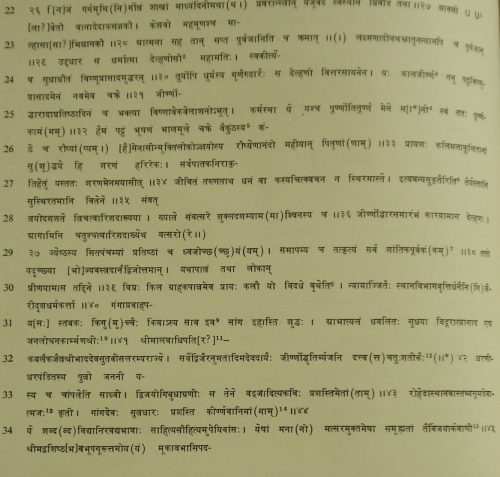| |
North
Indian Inscriptions |
| |
|
|
|
INSCRIPTIONS OF THE PARAMARAS OF CHANDRAVATI

____________________________________________________________
[1] The two letters giving a name are totally lost in the original.
[2] On the second of these aksharas a rēpha was at first engraved and later on erased, leaving the mark. The last letter is deformed.
[3] Originally sa, later on corrected by overwriting.
[4] The space for the mātrā of ā is left blank.
[5] This and the fourth foot of this verse show a wrong pause-fall.
[6] Probably to be restored to इत्यवेत्य सु
[7] That is, with observances or ceremonies calculated to remove calamities.
[8] This stich means that ‘he removed the order or the belief that a Brāhmaṇa is only to take and not to give’.
[9] The intended reading is perhaps सावयवसांग for सांगोपांग, with the main and subsidiary. The horizontal stroke of the preceding m is missing and thus it appears as g.
[10] The word kārmaṇa means witchcraft, for which, cf. Vikramāṅkadēvacharita (Bombay), II, 14 and VIII, 2.
[11] This akshara is blurred but the reading of the preceding one is certain and the one that follows it is rather deformed. Should we take it as –pati-dhashka in the sense of –dharsha or dhṛishṭa, meaning assaulting?. Sastri read the word as Turushka, but the mātrā of t is clear.
[12] Only the consonant of this akshara with the following visarga is certain and all the rest parts of it are corrected later on. The anusvāra above, too, is clear and some mātrā originally put above is above is scratched off. The reading of all these parts is uncertain.
[13] The first letter of the name may also have been Mū. But the consonant is more like S.
[14] In this line, and below too, the signs of anusvāra area only dots, some of which appear to have been inserted later on.
[15] The same person is mentioned in its sanskrit from Vijayāditya in 1. 3 above.
|
\D7
![]()
|








